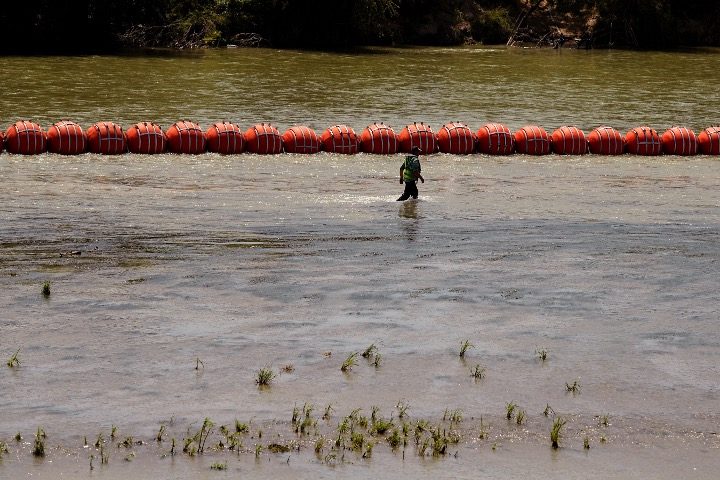
Texas has secured a major legal victory in its ongoing battle with the Biden administration over immigration enforcement along the United States-Mexico border. A U.S. appeals court ruled on Tuesday that the state can maintain a 1,000-foot long floating barrier on the Rio Grande, rejecting the Biden administration’s efforts to remove the structure.
As reported by The Texas Tribune, “the text of the decision was released by the court Tuesday evening, but then appeared to have been taken down shortly after.” They added that the lawsuit is set to be heard in district court soon, where a decision will be made regarding the merits of the Biden administration’s claims.
Texas Governor Greg Abbott lauded the court’s ruling, stating,
The Fifth Circuit last night delivered a victory for Texas’ historic border security mission by ruling that our floating marine barriers can stay in the Rio Grande River. Last year, Texas installed these barriers to deny dangerous and illegal river crossings, and almost immediately, the Biden-Harris Administration sued to remove them and obstruct our efforts to secure our border. We fought to keep these barriers in the water, and with the Fifth Circuit’s decision, that is exactly where they will remain. This fight is far from over. Texas will continue to defend our constitutional right to secure our southern border to keep our state and the nation safe.
Texas Attorney General Ken Paxton vowed to “continue to defend Texas’s right to protect its border from illegal immigration.”
DOJ Complaint
In July 2023, Texas installed a floating barrier of wrecking ball-sized buoys in a shallow section of the Rio Grande as part of Governor Abbott’s Operation Lone Star, a program aimed at deterring migrants from crossing the U.S.-Mexico border that was launched in March 2021. The Biden administration swiftly responded by filing a lawsuit against Texas on July 24, 2023, arguing that the state had acted unlawfully by installing the barrier without securing the necessary federal approvals, including from the U.S. Army Corps of Engineers.
The Department of Justice (DOJ), representing the Biden administration, claimed the barrier was posing “serious risks to public safety and the environment, and may interfere with the federal government’s ability to carry out its official duties.”
House Democrats and other critics of Abbott, who urged Biden to stop Texas from protecting its borders, lamented that the buoys were “putting asylum-seekers at serious risk of injury and death, interfering with federal immigration enforcement, infringing on private property rights, and violating U.S. treaty commitments with Mexico.”
Abbott’s Defense
Abbott defended the measure as a necessary response to the border crisis caused by the Biden administration’s open-border policies.
“It has been under your watch that migrants have suffered an unprecedented crisis of inhumanity,” Abbott wrote in a letter to Joe Biden in response to the lawsuit. “If you truly care about human life, you must begin enforcing federal immigration laws.”
The governor added that, when ordering the deployment of the barrier, he acted as “commander-in-chief of our State’s militia.” He said the barrier was intended to guide migrants toward legal entry points while discouraging illegal crossings and drug trafficking.
According to the Tribune, the state’s attorneys argued in court that the barrier iss not a structure requiring federal authorization. They also maintained that Texas had followed proper protocol by briefing the international commission that oversees the Rio Grande prior to the barrier’s installation.
In April 2024, U.S. District Judge David Ezra issued a preliminary injunction requiring Texas to relocate the barrier. This is the ruling overturned by the 5th U.S. Circuit Court of Appeals, allowing Texas to maintain the barrier while the legal proceedings continue.
How the Buoys Work
The floating barrier consists of large, heavy buoys tethered together and anchored in the riverbed. The design is intended to make it difficult for individuals to swim across the river at this location. The buoys are positioned in a way that makes them nearly impossible to climb over, acting as a physical deterrent to migrants attempting to cross the river illegally.
Texas installed the buoys near Eagle Pass, Texas, a location known for frequent illegal border crossings, and across from Piedras Negras, Mexico.
Enforcement at Work
Governor Abbott told Fox News in April that the number of migrants trying to enter the country through the Rio Grande into Eagle Pass had notably declined, quoting how the numbers had gone from thousands to just a few a day thanks to Operation Lone Star.
He also pointed out that while Texas has more than two-thirds of the U.S.-Mexico border, it had recently seen fewer illegal crossings than other border states.
Legal and Political Implications
The 5th Circuit’s ruling is a setback for the Biden administration and a victory for Texas officials, who have been at the forefront of legal battles with the federal government over immigration policies.
However, the legal fight is far from over. The administration’s lawsuit against Texas is still ongoing, with a trial scheduled to begin next week. The outcome of this case could have significant implications for the balance of power between state and federal governments in setting and enforcing immigration policy.
The administration has also been involved in legal disputes with other Republican-led states, including Iowa and Oklahoma, over their efforts to enforce state-level immigration laws that the administration argues are in conflict with federal authority.
Politically, this development poses further challenges for Vice President Kamala Harris, the presumed Democratic nominee for the presidency, who has been serving as the administration’s “border czar” since March 2021. This situation may intensify scrutiny of her role and effectiveness in addressing border-related issues that are of high importance for American voters.